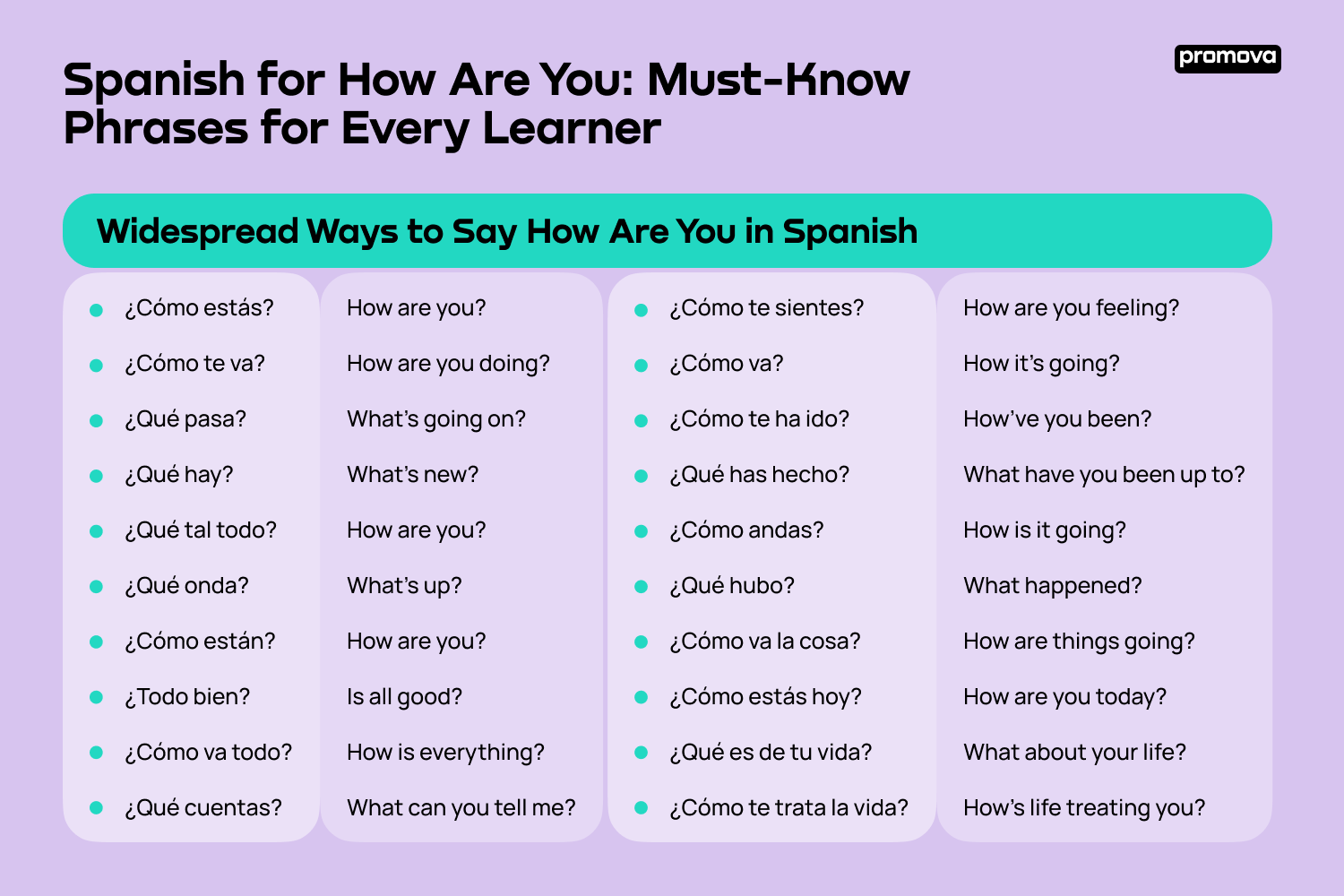Spanish for How Are You: Must-Know Phrases for Every Learner

Contents
Spanish is a rich language, and knowing its basics can help you cope with the language barriers in numerous countries. These encompass around 14 countries, except Spain, including Mexico, Argentina, the Dominican Republic, Costa Rica, etc. It’s one of the most widely used languages globally.
According to statistics, around half a billion individuals speak Spanish. The same research indicates it’s the mother tongue of 460 million people worldwide, so learning to say how are you in Spanish and other useful phrases will be helpful.
You will feel more free when traveling abroad, communicating with locals, applying for a job, or beginning your education in Spanish-speaking countries. After all, knowing a foreign language develops multiple skills. So, it’s time to learn how to say how are you in Spanish; catch a list of widely used expressions that may be useful for many. Starting from the basics is a practical solution when studying any language. Of course, Spanish is no exception; let’s dip into all its peculiarities.
Widespread Ways to Say How Are You in Spanish
This expression is the excellent beginning of almost every conversation, whether with friends and family or with those you’ve just met. Of course, you should first greet the person with “Hola,” meaning “hello” in Spanish. After that, it will be polite to ask how they are doing, and here are some ideas:
- ¿Cómo estás? – How are you?
- ¿Cómo te va? – How are you doing?
- ¿Qué pasa? – What’s going on?
- ¿Qué hay? – What’s new?
- ¿Qué tal todo? – How are you?
- ¿Qué onda? – What’s up?
- ¿Cómo están? – How are you? (used when talking to a group of people).
- ¿Todo bien? – Is all good?
- ¿Cómo va todo? – How is everything?
- ¿Qué cuentas? – What can you tell me?
- ¿Cómo te sientes? – How are you feeling?
- ¿Cómo va? – How it’s going?
- ¿Cómo te ha ido? – How’ve you been?
- ¿Qué has hecho? – What have you been up to?
- ¿Cómo andas? – How is it going?
- ¿Qué hubo? – What happened?
- ¿Cómo va la cosa? – How are things going?
- ¿Cómo estás hoy? – How are you today?
- ¿Qué es de tu vida? – What about your life?
- ¿Cómo te trata la vida? – How’s life treating you?
These are the most popular phrases you can hear in Spanish-speaking countries. Learn at least some to feel confident when communicating with natives. The above expressions are mainly used on informal occasions. You can use any of them, so learn the best phrases and enjoy the possibility of better understanding Spanish speakers and dipping into the country’s culture and traditions.

How Are You in Spanish in Formal Language
It often happens that a person starts their education or finds a job in a Spanish-speaking environment. Overall, it’s customary to be polite and ask co-workers or university acquaintances how things are going. In such instances, you can use the following expressions:
- ¿Cómo le va? – How do you do?
- ¿Cómo se encuentra? – How are you?
- ¿Cómo ha estado? – How have you been?
- ¿Cómo está usted? – How are you?
- ¿Cómo le ha ido? – How have you done?
- Y usted, ¿qué tal? – And how about you?
As you can see, there are not so many formal expressions, so memorizing them won’t take much time. But still, it’s important to learn them, as these phrases may be beneficial during business meetings or other important events.
Different Ways to Say How Are You in Spanish: Slang
As well as many other languages, Spanish is constantly developing, being replenished with slang words. Some expressions may sound weird to learners. But still, locals, especially youngsters, use these phrases to sort out how their interlocutor feels. Grab some terms to remain in trend in Spanish-speaking countries:
- ¿Qué rollo? – What’s up?
- ¿Qué pasa tío? – What’s up, man?
- ¿Qué más pues? – What else then?
- ¿Qué hongo? – What mushroom?
- ¿Qué más parcero? – What else, friend?
- ¿Bien o qué? – Are you good or what?
- ¿Qué tal weo? – What’s up, dude?
- ¿Y tú de qué? – And what of you?
- ¿Cómo estái? – How are you?
- ¿Qué sopa? – What soup?
Although it is not considered the traditional literary language, you can still hear these phrases. Try to learn them, as it’s your chance to understand natives better and boast your knowledge when communicating with them. Everyone will be impressed with such a profound understanding of the Spanish language’s peculiarities. Even though most experts recommend learning the basics first, we think familiarizing yourself with the widely used expressions is always a great idea.
However, keep in mind that the above phrases are only suitable for communicating with your close people. Don’t use them on formal occasions and choose more traditional ways to say how are you in Spanish. Now, it’s time to move forward and sort out everything about the most popular answers to this question.
Ways to Answer the Question
You already have multiple ways to ask a person what’s up. But what to do if a Spanish waits for the reply to the same question? Don’t worry, as we are here to help you. We’ve gathered a list of popular phrases that will help you feel more confident during communication and answer quickly:
- Estoy bien gracias – I am fine, thanks.
- Buena gracias – Good, thanks.
- Lo estoy haciendo bien – I’m doing well.
- Estoy muy bien – I’m great.
- Más o menos – More or less.
- No tan bien – Not so well.
- Bien, gracias, ¿usted cómo está? – Good, thanks, how are you?
- Muy bien, gracias por preguntar – Very good, thanks for asking.
- No me puedo quejar – I can’t complain.
- Nunca he estado mejor – I have never been better.
- He estado mejor – I’ve been better.
It’s worth noting that the Spanish mentality implies that you don’t have to be laconic. You can provide a comprehensive answer and discuss business, family, and other essential things. However, it only concerns informal communication. You must be concise when answering this question at work or business meetings, as in such instances, people don’t usually have much time for small talk.
You should always remember to be polite; if a person wants to know how you are doing, prepare to ask the same in return. So, it’s better to add “¿y tú?” meaning “and you?” In such a way, your interlocutor will understand you are also curious about how they feel. This approach will help you show your sympathy and find friends faster. Moreover, it will demonstrate your good manners, which are highly valued in Spanish-speaking countries.
13
Several Points to Learn Spanish Etiquette Better
Every country has its culture and language peculiarities. Locals are open to new acquaintances and always greet newcomers like old friends. So, don’t be surprised if a Spanish person kisses you on the cheeks and hugs you almost immediately after the first meeting. The country’s residents demonstrate their emotions by touching other people.
In addition, Spanish speakers are friendly and communicative. Therefore, asking how things are going is a must during every conversation. It’s always a great idea to give a fair and sincere answer since they will gladly listen to everything. However, don’t forget to do the same in exchange – be attentive to what your interlocutor says.
Spanish people don’t like silence, which is why they talk even when having dinner. Moreover, they value a good sense of humor, so remember to tell them your favorite joke, even if it’s your first meeting. A native speaker will appreciate your sincerity and friendliness, quickly making you closer.
Dipping into Spanish Traditions
Learning a language is not limited to simply memorizing words and phrases. Knowing the country’s traditions and customs is the best way to explore the culture and feel closer to Spanish residents. Of course, booking a tour around the region and communicating with locals is a top alternative. However, even if you are not planning a journey, knowing some norms and customs might be exciting.
- Siesta is probably the thing everyone has heard of – it’s a common Spanish tradition. Many locals prefer to take a nap at midday, usually from 2 pm to 4 pm. Many shops and restaurants are closed during this time, as nobody can disturb the owner’s sleep. Spanish residents love this tradition and have stuck to it for years. So, don’t be surprised if you will have to wait for a while to have your lunch or better think about the café in advance.
- Another unusual thing is that it’s common for Spaniards to throw litter on the bar floor. If you see it when having a cocktail, you should have no doubt this destination is worth attention and appreciated by locals. However, remember that throwing everything you want is not allowed; only toothpicks and napkins are what you’ll see on the floor. So, it’s better to find a trash can for other garbage items, not to give the impression of a bad-mannered person.
- Fiestas are also popular within the country. Every city or town has to throw at least one in a year. It’s a carnival, gathering thousands of people in one place. They have fun, drink, eat, and find new acquaintances.
- La Fiesta de Tomatina is the loudest event, where Spaniards throw tomatoes at each other. The festival is available for locals and tourists, so it’s a perfect way to practice your Spanish skills and, of course, fling tomatoes, which is simply fun.
Spain is unique, and it seems a lifetime is not enough to explore all its peculiarities. You’ve already learned about the most popular traditions, and you’ll find many more when learning a language and discovering locals’ habits and customs. Isn’t it another reason to motivate you to start your Spanish courses as soon as possible?
Learning Spanish Is More Accessible in Promova
Reaching a particular fluency level in Spanish is beneficial in many ways. The Promova app with guided courses is a suitable option for many learners, as it offers interactive lessons for users of different levels. We recommend students practice daily, and our platform provides everything for convenient learning. Thousands of useful words, exercises, and funny quizzes are available in the application or the web version.
The app is free, so everyone can download it with a few clicks and enjoy learning immediately without being tied to their location. We also offer a Premium subscription, which provides even more materials for successful language learning. Our Spanish teachers who are working on the courses are professionals with vast experience.
Conclusion
Spanish is one of the most widespread languages in the world, boasting over half a billion speakers. Learning it will be beneficial for travelers, those who would like to get their education abroad, or people passionate about different languages. Memorizing the popular ways to say how are you in Spanish is the basics, critical for communicating with the locals. Join Promova if you are eager to learn more and explore top interactive lessons to boost your knowledge.
FAQ
How much time does it take to reach the intermediate level in Spanish?
Of course, it all depends on the person’s goals and individual characteristics. However, those who’ve already reached a particular fluency level in Spanish mention that around 400–420 hours of class time are enough to get a B1. On the other hand, getting to the C1 stage requires a minimum of 780 hours.
Do I need to use any additional tools when learning Spanish?
Learning independently is possible in the modern world, as you can find numerous resources online. Therefore, there’s no need to spend hours in boring classes. Tools like the Promova app will help get the desired fluency level faster, but remember that daily learning is recommended. Online dictionaries are additional helpers; services such as Diccionario de la Real Academia Española and tuBabel are worth attention. By the way, the latter offers many slang words useful for students.
What are the most popular ways for Spanish how are you used by locals?
The classic and most widespread expression is “¿Cómo estás?” The phrase is suitable on all occasions, both formal and informal. For many, it’s enough to learn it and communicate with the Spanish-speaking people. Other options include “¿Cómo andas?” (how is it going) and “¿Cómo te va?” (how are you doing). However, Spaniards also use slang that may often sound freaky. For instance, don’t be surprised if your friend says “¿Qué tranza?” translated as “What scam?”. But yes, it also means how are you in Spanish in an informal way.
What is the best way to break the ice and start talking with a native Spaniard?
Asking, “¿Hola, cómo te llamas?” which means “Hello, what is your name?” is a suitable solution when you start a conversation with a stranger. Afterward, you can ask how things are going and discuss common topics like the weather. Another option is trying to find something in common – talk about what you enjoy, and maybe your interlocutor shares the same interests. Native Spanish people are usually friendly, so finding new friends and becoming close is not difficult.



Comments